The most important among the huge number of muscles in the human body is the heart, on which everything depends. Before stopping to perform its function - to pump blood - and stop, this muscle will try to contract even weakly. And at this moment there is every chance to save a person if there is a defibrillator nearby - a medical device for electrical impulse therapy and the only means to save human life in this case. Violation of the heart rhythm cannot be predicted, and its failure can be restored only with the help of this device, and this must be done as quickly as possible. The editorial staff of the site "bestx.htgetrid.com/en/" offers to get acquainted with the rating of the best defibrillators for 2020.
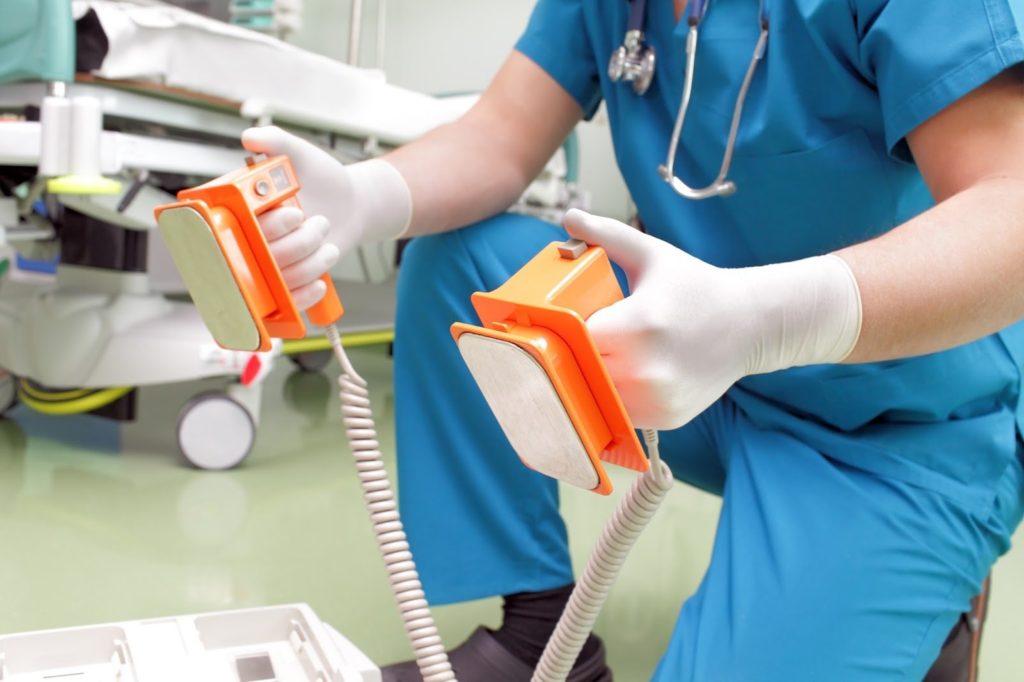
Content
What is it and what is it for
The meaning of this device can be understood through its very name: when the heart muscle begins to contract unevenly, arrhythmically, fibrillation occurs. The functionality of this tool lies in the goal of leading to the disintegration of this process, that is, defibrillation. The device generates a short impulse and, using an electric current, synchronizes and evens out the heart rhythm. The patient undergoes shock therapy, receiving 300 J of electricity, but this procedure prevents death.
This method was tested on animals as early as 1899, and only in 1947 on humans.
This invention in medicine is really important and necessary, because only with the help of its use it became possible to solve problems in case of heart rhythm disturbances. In the future, the question arose about the urgency of its use - in order to do without the consequences for human health, the device must be used as quickly as possible, the count goes for minutes. Some patients died in the ambulance - they simply did not have time to get to the machine. To solve this problem, a portable defibrillator was invented in 1965, which could be equipped with ambulances. The weight of this equipment reached 70 kg, respectively, there was something to work on - on the invention of a lighter and more mobile portable device. Currently, there are various portable devices that allow the doctor to take them with him when leaving to the patient, they should be equipped with ambulances. Moreover, there is a bill and there is a question of adopting a law that will allow the use of external defibrillators not only for doctors, but also for "an unlimited number of people."
We are talking about the need to install these devices in crowded places: airports, railway and bus stations, metro stations, sports facilities, swimming pools, fitness centers and gyms. This measure can save many human lives, when help is needed immediately and the effect of an electric current on the heart will prevent death.
What are
Modern devices are multifunctional, they are used as a pacemaker and cardioscope. In general, its mandatory building blocks are:
- display showing heart rate;
- speaker providing voice guidance;
- a microphone recording dialogs for further analysis;
- electrode providing automatic selection of the discharge force;
- discharge button;
- off button.
And then they can be divided into types;
- professional;
- automatic;
- combined;
- implantable.
- Devices of the first type are used in intensive care units and emergency departments, with which only doctors with the appropriate qualifications are allowed to work, because they must be able to determine the power of the discharge and the time of its exposure independently and taking into account each individual case, often in emergency conditions and lack of time ... The device itself consists of two electrodes, which are very important to place them correctly during the procedure. This type assumes the reusable use of electrodes, which saves the cost of consumables. But, since it is designed for hospital use, it is large and needs special maintenance.
- The automatic device is smaller and does not require special training from the doctor. It is able to detect the failure of heartbeats by itself and signal the need for a charge. Instead of so-called irons, he has electrodes that are attached to the chest with special Velcro. People even with basic medical training are allowed to work with them, which makes it possible to use them by rescuers, trainers, relatives of those suffering from arrhythmia. They are compact and lightweight, they are equipped with hotels, long-distance transport. Despite all the advantages, defibrillators of this type do not have some of the functions of professional devices, moreover, their cost is quite high.
- Combined, or universal, combine the functions of professional and automatic models - they have a display, printer and elements for manual control.
- The implantable device is sewn into the body or fixed on it for constant monitoring of the heart rate and the effect of electric current on the muscle, if necessary. Among them, monophasic and bipolar are distinguished, which are more often used due to the greater efficiency of the type of generated pulses.
Recommendations and advice
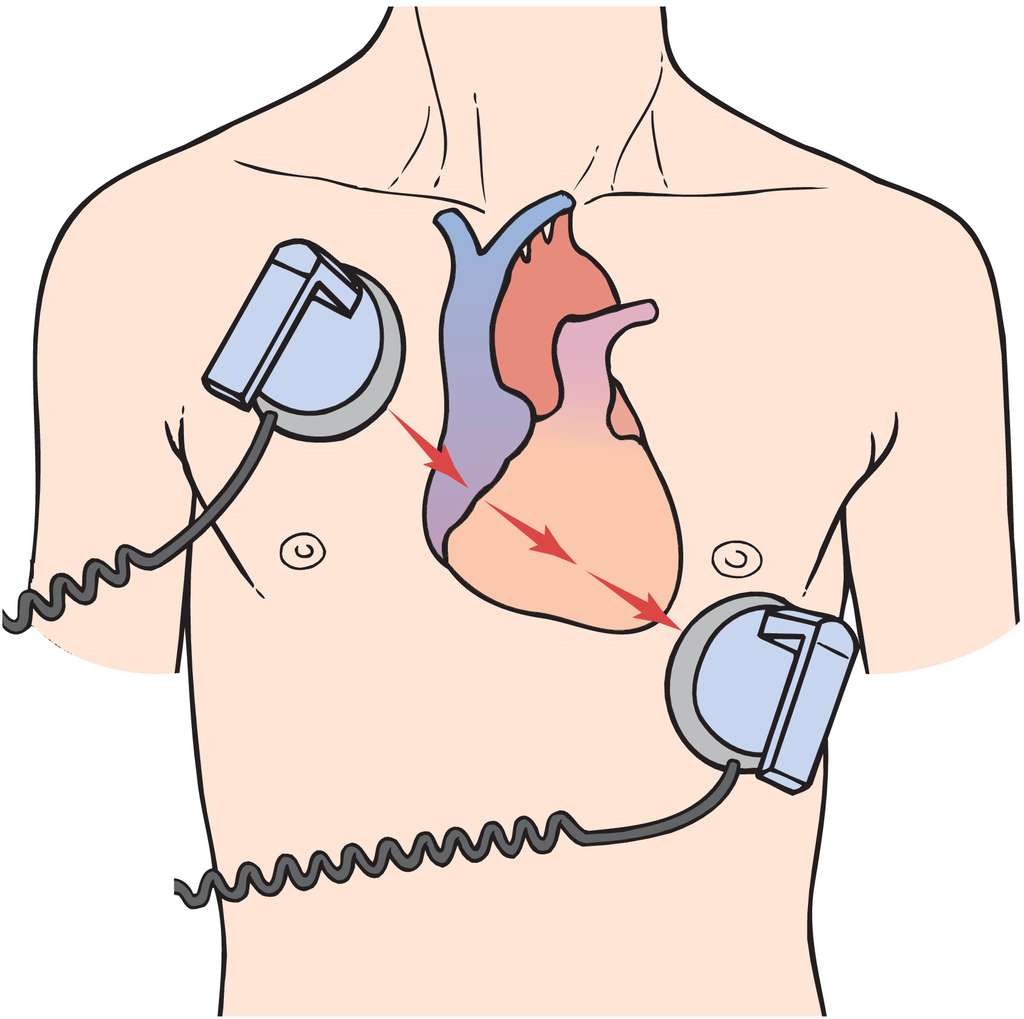
The indication for the use of a defibrillator is an ECG reading - a graph with a large number of small jumps up and down on the line, which indicates a different strength of contractions of parts of the heart. To even out the rhythm of the heartbeat, an electric discharge is needed, in power exceeding muscle contraction. This procedure makes sense precisely with such a curve, if the asystole process has begun, which is expressed on the monitor by a straight line, the use of the apparatus is meaningless due to the lack of electrolytes, which are needed for the impulse, in the cells. Defibrillation will only hurt here - the heat from the discharge can burn the heart. In this case, another set of resuscitation measures is needed. That is why it is important to consider the indications and contraindications for the procedure.
Indications include:
- fibrillation and / or flutter of the ventricles;
- atrial flutter.
Emergency defibrillation is used for fibrillation - an arrhythmic contraction at a speed of 200 to 300 beats per minute. In other cases, they resort to a planned procedure, the contraindications for which are:
- blood clots in the atrium;
- sinus or polytopic atrial tachycardia;
- electrolyte disturbances;
- contraindications to anesthesia;
- poisoning with glycosides.
An absolute contraindication, as already noted, is cardiac arrest when other measures are needed: mechanical ventilation, chest compressions, the introduction of atropine or adrenaline.
All these manipulations are carried out by a specialist, he also makes decisions. As a rule, all this is possible in a hospital setting. But, due to the proliferation and availability of defibrillators, anyone can learn how to use them by taking special courses. This is especially recommended for people whose work is related to people: sports coaches, instructors, employees of railway stations or airports. This skill will also be useful for people whose relatives suffer from cardiac arrhythmias.
Cautions when using the machine:
- Before attaching the electrodes, do not wipe the chest with liquids containing alcohol.
- When delivering a shock, to avoid getting an electric shock, do not touch the patient.
For those wishing to organize courses on use in medical institutions and the Red Cross, where you can get acquainted with training devices and practice on them. In addition, there you can learn the principle of AED operation and acquire basic skills:
Criterias of choice
To choose which device is better to buy and what to look for, it is necessary to take into account the conditions of its use and the main characteristics of the device:
- a type;
- control method;
- the rate of energy gain;
- power;
- battery capacity and charging time.
Let's take a closer look.
- Defibrillators are monophasic (transmitting a discharge from one electrode to another located in a strictly defined order) and biphasic (from the electrode, the discharge passes twice through the heart muscle and is reflected from the other, so their location is not important).
- According to the method of tool management, the following types can be distinguished:
- on hand - multifunctional and intended for use by professionals;
- on automatic - they can be used with basic medical training, since the device itself recognizes problems in the heart rhythm.
- The division is very arbitrary, since models of both types may have common features: a number of automatic functions for manual devices, some functions of manual operation for automatic devices.
- The power should be not less than the fibrillation threshold, ideally equal to it, but the acceptable values are not much higher. Otherwise, the discharge will not transfer the myocardium to a repolarization state. For two-phase devices, it should be 200 J (5000 V), for single-phase devices - 300 J (approximately 7000 V).
- The time it takes to fully recharge your device is a measure of speed. On average, it should take 6 to 10 seconds.
- The battery capacity determines the duration of the defibrillator operation without using the mains, the average indicator is about 2000 mAh. The time required for charging is usually from an hour to one and a half. It should be noted that one of the operating conditions of the devices is to prevent additional charging of the device when its level is more than 50%.
In addition, in order not to make mistakes when choosing, you should pay attention to parameters such as weight and size (if necessary, transportation) and the size of the monitor.
Where to buy and how much does it cost
You should treat such an important purchase with caution and in no case make it in doubtful places. Some unscrupulous manufacturers offer branded defibrillators, the characteristics of which claim to be able to cure any disease through auxiliary functions. But, as you know, the only purpose of the devices is to restore the heart rate. Therefore, avoid deception and contact specialized medical equipment stores that sell equipment for intensive care units, or trusted online stores where the goods can be ordered online. The support service will provide consultation with specialists who, taking into account an individual request, will select the optimal model. In addition, they will provide after-sales service, a warranty period, a flexible system of prices and discounts, and offer a large selection of models from different manufacturers at different prices. Defibrillators cost from $ 20,000 to $ 300,000, but remember that this sometimes becomes the price for life and its quality.
Best defibrillators
Manual control
PRIMEDIC Defi-B
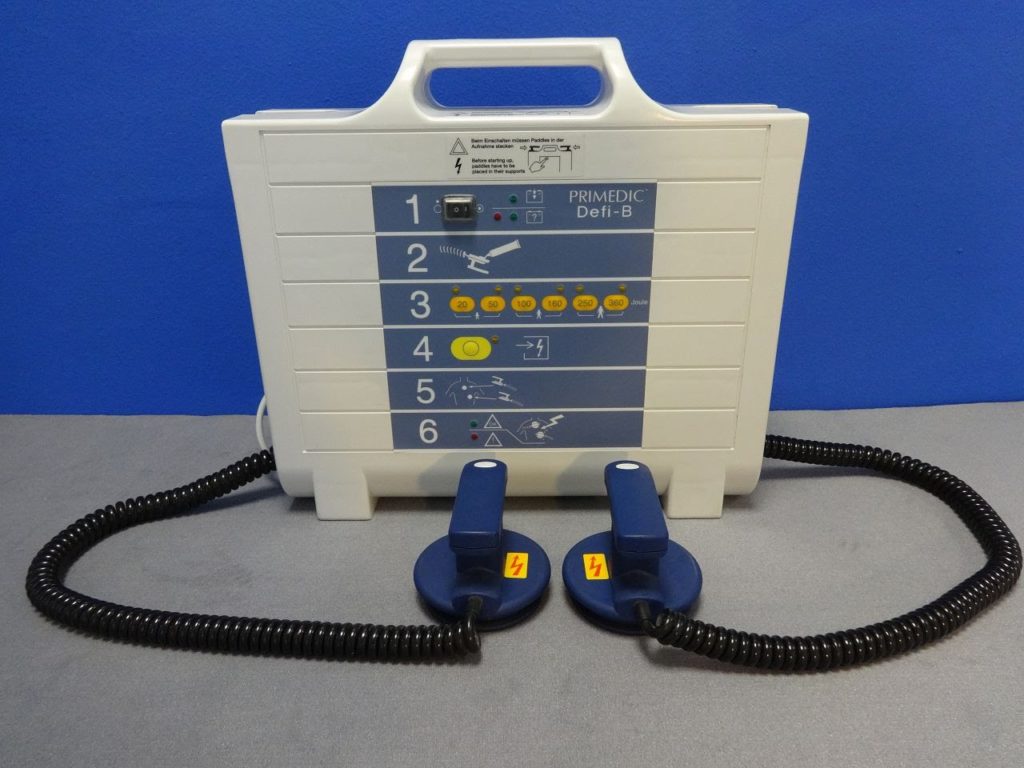
Apparatus manufactured by METRAX GmbH, Germany. The best option for use in intensive care vehicles and hospitals. Special training is required to operate the device. To record an ECG, you need to purchase an additional device, since the model does not have a built-in monitor. It works on the principle of asynchronous external defibrillation in manual mode, giving a pulse with a monophasic waveform. Power - 360J, with a charged battery, the guarantee for 35 discharges.The device has a built-in charger. The body of the product is made of durable plastic resistant to mechanical damage. The touch keyboard is equipped with symbols and instructions, there is a function for testing device malfunctions. Reusable electrodes for adults have built-in children. Cost - from 90 thousand rubles.
Advantages:
- does not depend on the electrical network;
- fast energy gain;
- equipped with baby electrodes;
- reusable consumable;
- durable body;
- inexpensive.
Disadvantages:
- without ECG monitor;
- only medical workers can work.
Beneheart D3 "MINDRAY"
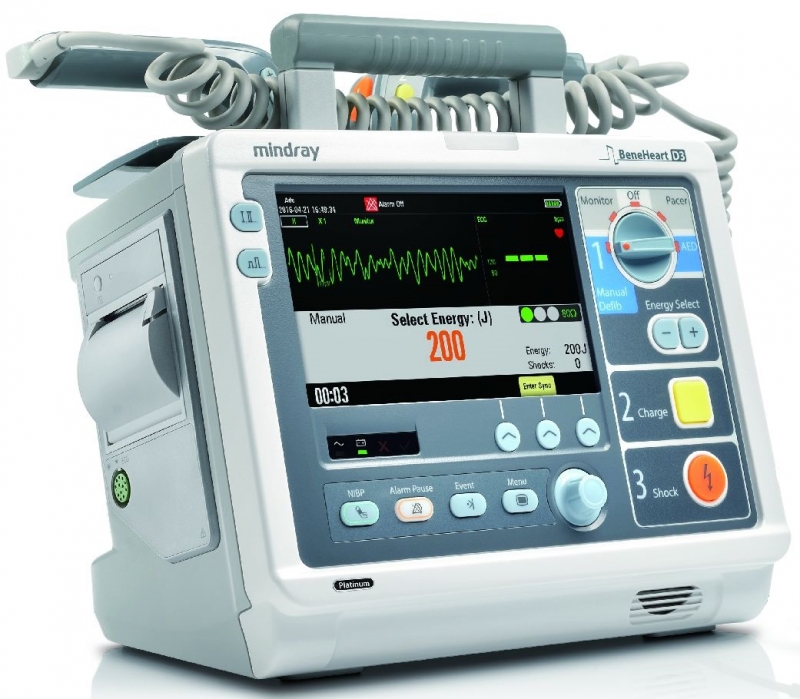 The defibrillator is indicated for external and internal procedures and performs pacing and ECG monitoring. Designed for hospitals, hospitals and intensive care units, can only be used by medical personnel. Advanced technology in the design of the device allows for manipulations such as cardiac pacing, cardiac pacing, semi-automatic defibrillation mode. The complete set of the device includes everything necessary for operation: monitor, pacemaker, manual and automatic defibrillator, reusable electrodes. Degrees of protection against dust, moisture, mechanical damage are provided. Charging takes 5 seconds. It costs from 490,000 rubles.
The defibrillator is indicated for external and internal procedures and performs pacing and ECG monitoring. Designed for hospitals, hospitals and intensive care units, can only be used by medical personnel. Advanced technology in the design of the device allows for manipulations such as cardiac pacing, cardiac pacing, semi-automatic defibrillation mode. The complete set of the device includes everything necessary for operation: monitor, pacemaker, manual and automatic defibrillator, reusable electrodes. Degrees of protection against dust, moisture, mechanical damage are provided. Charging takes 5 seconds. It costs from 490,000 rubles.
Advantages:
- high-precision equipment;
- advanced features;
- applicable to children from 8 years old;
- charging speed;
- gentle load mode.
Disadvantages:
- cost.
Automatic
DA-N-01 Axion

The device of the domestic manufacturer - the Axion concern - is a convenient portable device due to its small size and weight with a single biphasic effect. The model is equipped with a help system with voice, text and light prompts to recognize and execute commands. The size of the display and the function of adjusting the brightness and audio level ensures that information is clearly displayed. With the help of special electrodes, the device becomes suitable for helping even children. Reconfiguration occurs automatically, taking into account which electrodes are connected, if necessary, the discharge level decreases. The defibrillator monitors the heart rate and analyzes its stability and determines if a pulse is needed. The powerful battery provides 12 hours of continuous use. Cost - from 150 thousand rubles.
Advantages:
- automatic signaling mode;
- can be carried due to its small size and weight;
- 7-inch screen;
- suitable for adults and children;
- automatic adjustment of the discharge level;
- Wi-Fi function is available, providing surveillance from a distance.
Disadvantages:
- not found.
HeartStart FRx PHILIPS

A quality device from Philips will provide invaluable assistance in an emergency - in case of cardiac arrest. Designed for use both in a hospital or medical transport, and at home. The moisture-resistant, robust case is protected from dust and shock, the accessible interface allows a person without special training to carry out procedures. The manufacturer provides service under warranty. This model can be used to help adults and children, starting from a newborn age. Detailed instruction in the form of voice commands, audio prompts and metronome responses makes the layman's job easier. It also contains training programs and is equipped with training electrodes. The average price is from 130 thousand rubles.
Advantages:
- lightweight, mobile;
- withstands temperature drops;
- lasting;
- quality assurance;
- all safety requirements are taken into account;
- does not require special knowledge and skills from the user;
- applicable to children.
Disadvantages:
- not found.
ZOLL AED Plus
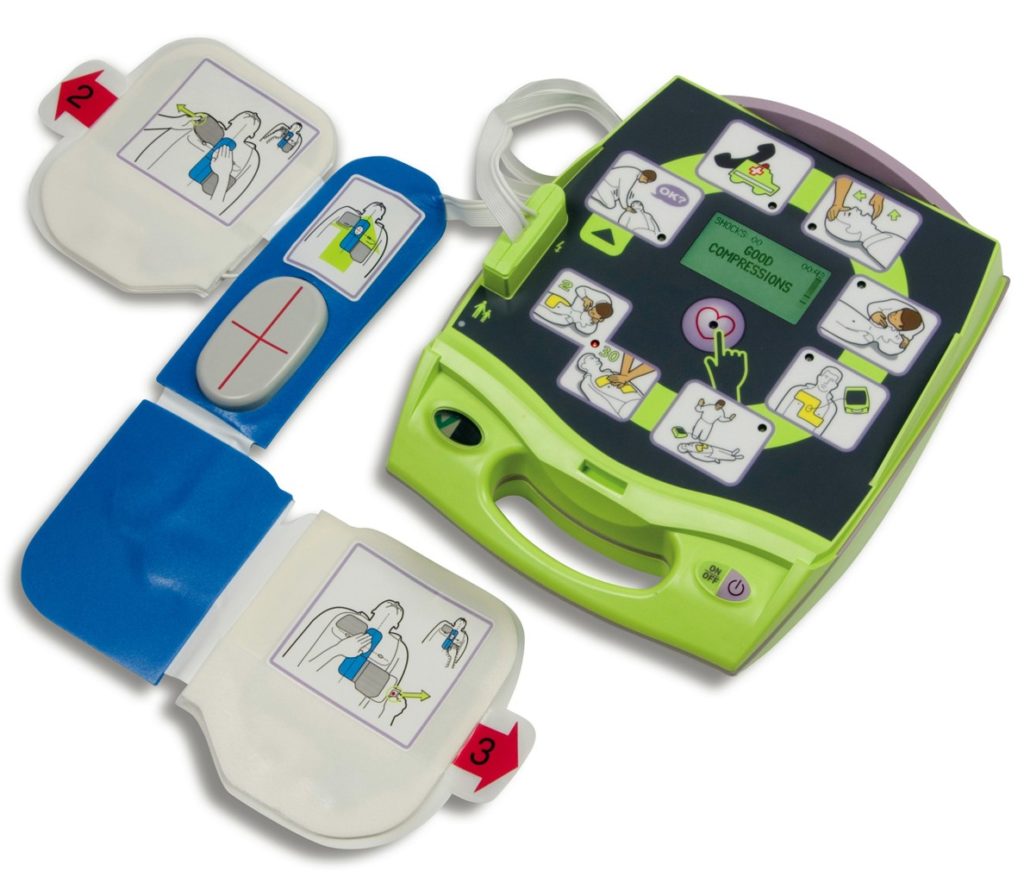
The products of the American company ZOLL Medical Corporation are an automatic device that can be controlled by a person without medical education and training. Even a casual passer-by can do emergency cardiopulmonary resuscitation.The model's capabilities - display, accessible interface, voice guidance - allow avoiding mistakes during the procedure. The D-Pad function analyzes the correctness and strength of pressing. A rectangular biphasic pulse with a maximum power of 200 Joules reduces the risk of myocardial injury. The feedback from the device, which is provided by its options, allows you to monitor all actions of the rescuer and correct them if necessary. The model is equipped with a metronome, a patented single electronic fingerboard, eliminating overdubbing errors. Powered by standard lithium batteries with a lifetime of up to 5 years. The display provides the display of all necessary indicators. The average cost is from 200 thousand rubles.
Advantages:
- use of electrode technology to facilitate work;
- safe but effective boost;
- voice acting of voice and text prompts in Russian;
- comfortable single pad;
- built-in LCD display.
Disadvantages:
- absent.
AVD-1P BIOS
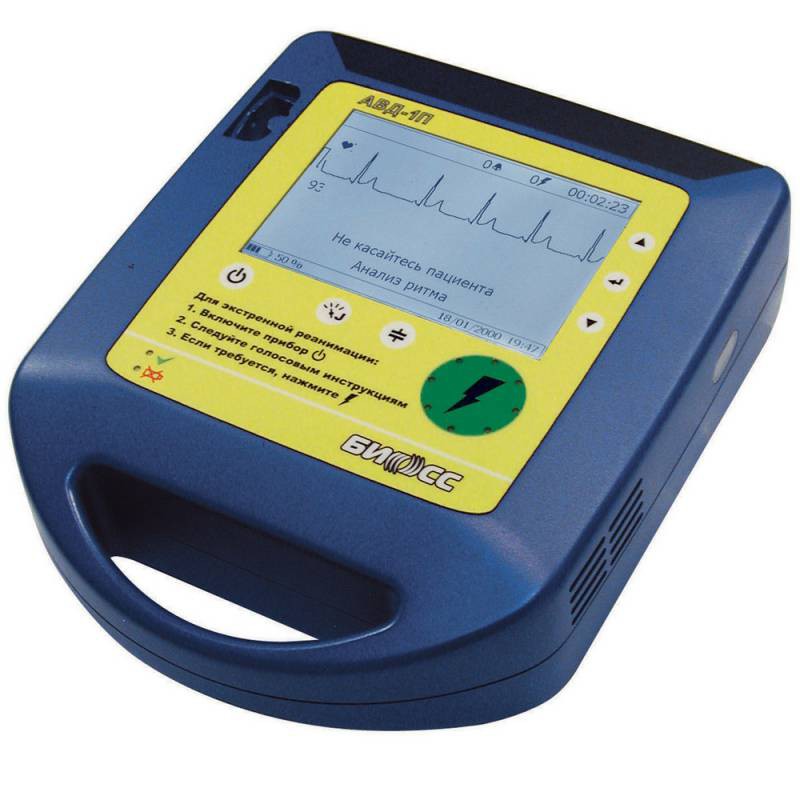
Control of this model is available in manual (with the possibility of cardiac synchronization for cardioversion) and automatic (in compliance with the international defibrillation protocol) mode. It takes 15 seconds to automatically detect heart failure. When implementing the automatic mode, assistance is provided in the form of voice prompts, which allows non-professionals to work with the device. In general, this model is suitable for equipping ambulances, firefighters, police groups, emergency teams. Its small size and weight does not make it difficult to transport. The use of disposable electrodes in the process ensures efficiency. A full charge is enough for 120 charges, the duration of a pulse charge is about 10 seconds. Cost - from 190 thousand rubles.
Advantages:
- two control modes;
- simple control in automatic mode;
- lightweight, mobile;
- full set;
- disposable electrodes;
- the memory records the ECG.
Disadvantages:
- absent.
The editors of the site "bestx.htgetrid.com/en/" provided a rating of the best defibrillators and reviewed the characteristics of the devices. Given the importance of this device in saving lives, the choice should be made very seriously and deliberately, taking into account all the conditions and purposes of use. We hope, with the help of our description, it will be done correctly, and you will leave your feedback about the selected unit.












